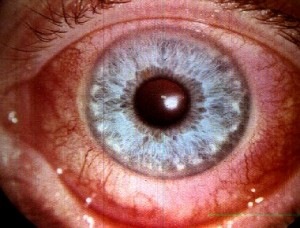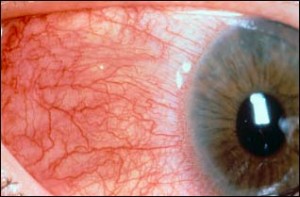Scleritis is a rare inflammatory condition that reportedly affects less than 1% people who visit ophthalmologists. Read and know more about the causes, symptoms, and treatment of this disease.
What is Scleritis?
Page Contents
It is an inflammatory disease that affects the white outer coating of eye. The condition is manifested by an inflammation of sclera. Sclera is the tough outer white ocular coating that provides white color to the eye and also maintains its shape. This layer may swell due to diseases like granulomatosis and rheumatoid arthritis. Inflammation may also be caused due to disorders of menstruation.
Types of Scleritis
There are two main types of this condition:
Picture 1 – Scleritis
Anterior scleritis
The occurrence of Anterior scleritis is more common in comparison to that of other forms. Research shows that anterior form occurs in about 94% of patients while the posterior type is observed only in the rest of the patients.
The anterior form can be further divided into:
- Diffuse Anterior Scleritis: This is the most common type of Anterior scleritis and is recognized by well distributed inflammation of the anterior sclera.
- Nodular Anterior Scleritis: In this type, nodules are found to arise on the interior surface of sclera.
- Nectrotizing Anterior Scleritis with inflammation: It is marked by extreme pain.
- Nectrotizing Anterior Scleritis without inflammation: It is characterized by rheumatoid nodule in the sclera and is also known as Scleromalacia perforans.
Posterior scleritis
It is a rare form but may give rise to pain during eye movement, serous retinal detachment and loss of vision.
Causes of Scleritis
Know about the main causes of this ocular disorder:
- Any underlying disorder, that affects the body internally, can be a common cause of this condition. These include auto-immune and connective tissue disorders.
- An infection caused by any fungi, parasite or virus may also lead to this disorder.
- An infection caused by any fungi, parasite or virus may also lead to this disorder.
- Episcleritis is another common cause of the disease. Episclerits is a less severe problem that involves the inflammation of episclera. In some cases, Episcleritis develops into Scleritis.
Some of the disorders associated with the condition include:
- Systemic lupus erythematosus
- Rheumatoid arthritis
- Polyarteritis nodosa
- Mixed connective tissue disease
- Wegener’s granulomatosis
- Polymyositis
- Sjogren’s syndrome
- Giant cell arteritis
- Inflammatory bowel disease
- Scleroderma
In 20-30% of cases, the cause of Scleritis is unknown.
Pathophysiology of Scleritis
Sclera (the affected layer of the eye in this case) mainly consists of collagen and elastic connective tissue. Scleritis involves enzymatic degradation of collagen fibril. Moreover, the T cells and macrophages are also affected during the process. Inflammation of sclera may further result in necrosis and ischemia.
Symptoms of Scleritis
This condition gives rise to a number of symptoms that can help in its diagnosis. These include:
- Pain in the eye, which tend to increase with time. The intensity of pain is more when patients wake up in the morning. The extreme pain associated with this disease is used to differentiate it from similar diseases of the eye, such as Conjunctivitis.
- Redness in the eye
- In some patients decrease in visual ability has also been observed.
- Patients have also reported of increased sensitivity to light, a condition that is known as Photophobia.
Diagnosis of Scleritis
The condition can be detected by various techniques, such as.
- Simple visual inspection of sclera in day light
- Retracting the lids, to judge the intensity of the problem
- CT scans and MRIs, for confirmation of the disease.
However, a physical inspection of eye is enough to diagnose this disorder. It is, thus, commonly used.
Treatment of Scleritis
A number of drugs are available for the treatment of this disorder. The use of drugs varies from one patient to another depending on the severity of the symptoms. In severe cases, a combination of drugs may be prescribed by the doctor. The treatment of the disorder may involve:
Picture 2 – Scleritis Image
Anti-inflammatory Medications
Anti-inflammatory medications, such as Prednisolone acetatae eye drops, show effective results in curing the condition. However, the response to these eye drops tends to vary from one person to another.
NSAID
Oral NSAIDs (non-steroidal anti-inflammatory drugs) are also recommended to people suffering from this disease. These are an important part of the initial treatment of the condition.
Oral Corticosteroids
Corticosteroids are also prescribed to people suffering from Scleritis. The dosage of these medications tends to vary from one person to another and depends mainly on the tolerance level of patients. While using corticosteroids, various body parameters of the patient such as weight and blood sugar should be properly monitored.
Immunosuppressive drugs
Once the symptoms are treated with NSAIDS and corticosteroids, immunosuppressive drugs are administered to patients for complete elimination of this disease. Methotrexate, Ciclosporin and Mofetil are some drugs that belong to this category.
Surgery
In some cases, surgery may be performed to tackle the problems caused by inflammation. Operative methods are mostly used to relieve the symptoms of necrotizing scleritis.
If left without treatment, the condition may lead to loss of vision. Due to this, it is necessary to seek medical attention as soon as you spot the symptoms of this disorder. Early treatment will help you check the condition in time and prevent complications associated with vision.
References:
http://en.wikipedia.org/wiki/Scleritis
http://www.medicinenet.com/scleritis/article.htm
http://www.patient.co.uk/doctor/Scleritis-and-Episcleritis.htm
http://emedicine.medscape.com/article/809166-overview#showall



